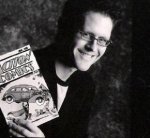Techlander Mike Williams came across the Amazon page for The Jedi Path: A Manual for Students of the Force by Daniel Wallace a month or two ago, so we tracked down the author to ask him about it. And here’s what happened.
 What’s your earliest memory of Star Wars?
What’s your earliest memory of Star Wars?
Daniel Wallace: I saw the original in the theater. But only after a lot of prompting by my friend, who kept unhelpfully describing Star Wars to me as “the movie where the space people get stuck in the garbage disposal and somebody turns it on.” In my head I had a picture of tiny “space people” with antennae and wings who got stuck in somebody’s kitchen sink.
What does it mean to you today?
DW: Like a lot of people of my generation, I wouldn’t be doing what I do if it wasn’t for Star Wars. The cultural impact of the saga was like a depth charge, felt most intensely among the very young. I wouldn’t be writing if it wasn’t for Star Wars, and I’ve met lots of people who wouldn’t be in film, animation, or the sciences for the same reason.
How did you get started in the Star Wars universe?
DW: In the mid-1990s I reconnected with my fannish side thanks to the Internet. Just for kicks I made my own guide to Star Wars planets and made it available for download from AOL’s file libraries. With the Internet still being the Wild West I was able to hop barriers and get to know a lot of Star Wars writers, leading to an offer to write an official book — Star Wars: The Essential Guide to Planets and Moons.
Of all the reference guides you’ve written about Star Wars, what was the most difficult?
DW: I’ve written more than a dozen reference guides to Star Wars, each one more complex than the last since it only seems fair to the fans to offer more bang for their buck. The toughest would be the newest, namely Star Wars Year by Year. This is a real-world look at the Star Wars phenomenon from the early 1960s to 2010, which required me to research the ‘dead years’ from 1984-1996. I learned more about Japan’s George Lucas Super Live Adventure Show than I ever thought possible.
Super Live Adventure Show?
The Super Live Adventure was a 1993 stage show (produced by Kenneth Feld) that toured Japan and included elements from Star Wars, Indiana Jones, Willow, American Graffiti, and more. You can read more here.
Favorite movie?
DW: My favorite movie is the original: Star Wars Episode IV, A New Hope. It’s amazing to see how successful George Lucas and ILM were at creating a believable universe given the timing and budget restrictions imposed by the studio. Consequently I’m not a big fan of the Special Edition, because it takes some of the focus away from the pioneers who made magic inside a sweaty warehouse using castoff model kits and cameras mounted on gimbals.
Favorite character?
Lando. He’s criminally underused. He’s basically the Star Wars James Bond. Who wouldn’t want to watch a Lando movie?
Of all characters that have been canonized, who should have their own series of books or comics?
DW: Well there’s dozens of movie characters. And I wrote Star Wars: The New Essential Guide to Characters, so I have a good handle on the sprawling cast that has also been introduced in the books, comics, and video games. If I were to launch a spinoff I’d choose Admiral Ackbar. I bet you could have a lot of fun with what is essentially Lobster Winston Churchill, as long as you didn’t abuse his catchphrase of “It’s a trap!”
What books in the expanded universe would you recommend?
DW: If you’re just getting started and want an overview, I’d recommend Star Wars: The New Essential Chronology (which I co-wrote). If you’re looking for a good starter novel, the traditional entry point is Star Wars: Heir to the Empire by Timothy Zahn, which picks up the action a few years after Return of the Jedi. It’s nearly 20 years old but still a great read.
There’s quite a lot of material in the expanded universe. How did you create the Essential Chronology with so much material out there. Is everything canon? Did you have to consult the keeper of the Holocron?
Officially everything in the Star Wars publishing universe is canon, though George Lucas retains creator privileges to override anything he wants. Lucasfilm employs a “Keeper of the Holocron,” namely Leland Chee, to keep it all straight. In this Star Wars is unique from most other franchises. DC, for example, keeps the Batman comics separate from The Dark Knight movie and Arkham Asylum the video game.
We’ll be talking a little more about the Jedi Path next week but why did you decide to do this? It makes perfect sense but why hasn’t it been done before?
DW: We’ve never made the connection before to produce a book that was also an artifact. The Jedi Path is meant to be something that fell out of a wormhole into our universe from a galaxy far, far away. And from a reader and collector standpoint, it’s both a book and a box of souvenirs.
How was Celebration V?
DW: Star Wars fans are hugely friendly and welcoming. And the best part is that it’s so cross-generational. There were tons of kids at CV, and for them the Clone Wars TV series is their Star Wars.


